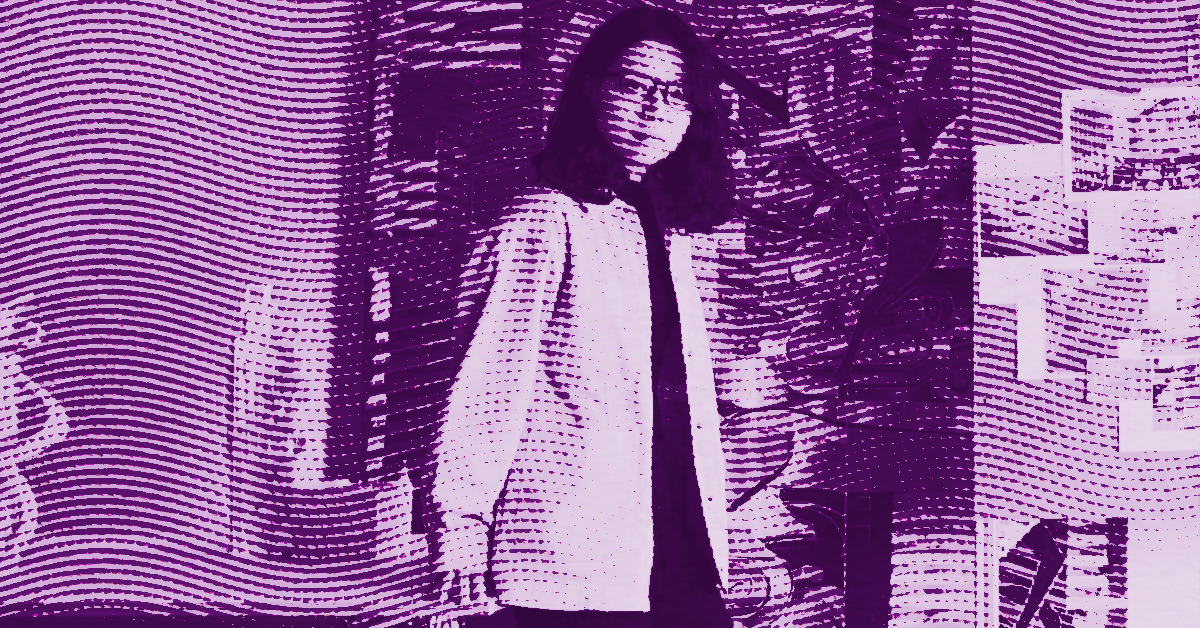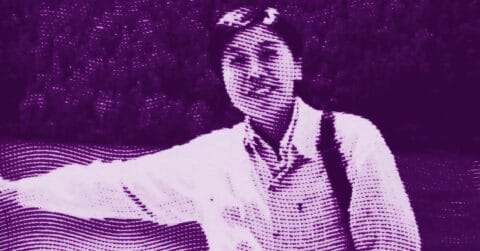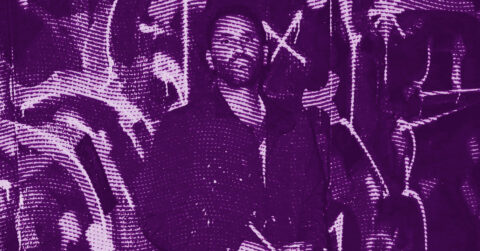Listen to me carefully, you bunch of snobs: Cui Jie paints the displaced soul of Chinese modernity with the surgical precision of an urban planner and the melancholy of a poet. In her paintings with tart colors, where giant cranes seem to embrace telecommunications towers and where socialist sculptures converse with Japanese metabolist architecture, this artist born in Shanghai in 1983 maps the psychogeographic layers of an empire in perpetual reconstruction.
Her work confronts us with a disturbing truth: we all now live in the anticipated rubble of our architectural utopias. For more than a decade, Cui Jie has documented this condition with an acuity that goes far beyond a simple urban chronicle. She reveals how constructed space shapes our subjectivities as much as it results from them. “When I paint buildings, I am actually painting my emotions,” she confides with a simplicity that masks the theoretical sophistication of her approach [1].
Social space as a battlefield of modernity
To understand the scope of Cui Jie’s work, it is necessary to situate it within the conceptual framework developed by Henri Lefebvre, the French philosopher who revolutionized our understanding of urban space. In his trilogy on the critique of everyday life and his major work “The Production of Space,” Lefebvre demonstrates that space is never neutral: it is both produced by social relations and producer of those same relations [2]. Space thus becomes a political issue, a field where power relations are played out and where the contradictions of advanced capitalism crystallize.
This sociological approach resonates strikingly with Cui Jie’s practice. When she superimposes in her compositions fragments from Beijing and Shanghai, when she makes a Soviet sculpture dialogue with a skyscraper from Hong Kong, she intuitively implements what Lefebvre theorized: differential space that resists capitalist homogenization. Her paintings reveal how different eras of Chinese modernization, from socialist aesthetics to borrowings from Japanese metabolism, through the adoption of Western architectural codes, coexist in a stratified urban testimony where each layer tells a particular story of power.
The artist proceeds by montage, a technique she explicitly claims by citing Orson Welles as a major influence. This cinematographic approach allows her to reveal what Lefebvre called the “contradictions of space”: how the same place can simultaneously bear the marks of Maoist collectivism and the individualistic aspirations of the market economy. In “Worker and Cultural Palace Dongguan” (2014), she thus juxtaposes a cultural palace, a typically Soviet typology, with monumental sculptures celebrating scientific progress, creating a composite image that condenses several decades of spatial ideology.
This approach goes far beyond simple architectural documentation. Cui Jie reveals how Chinese urban space functions as a device of social control, where each building bears the traces of a political project. Her works reveal what Lefebvre called “conceived space,” that of planners and technocrats, but also “lived space,” that of the daily experience of inhabitants. When she paints Beijing’s pedestrian bridges or Shanghai’s office towers, she captures this tension between the space programmed by public authorities and the space appropriated by social uses.
Cui Jie’s innovation lies in her ability to make visible the ideology inscribed in stone and steel. Her non-naturalistic colors, these artificial mauves, electric oranges, and synthetic turquoises, act like a chemical reagent that unveils the symbolic violence of contemporary architecture. She shows how Chinese urban spaces, far from being mere neutral containers, actively participate in the production of new forms of capitalist subjectivity. The modern office, with its curtain walls and modular spaces, is not just a workplace: it constitutes a machine to manufacture new types of individuals, adapted to the demands of the globalized economy.
The literary territory as a space of resistance
Cui Jie’s approach finds a remarkable echo in the literary practice of Mo Yan, 2012 Nobel Prize in Literature, who built his entire work around an imaginary territory: Gaomi County, in Shandong province. Like the painter, the writer proceeds by superimposing multiple temporalities, mixing official history with popular legends, the real with the fabulous, to create a narrative space that resists cultural homogenization.
This proximity of approach is no coincidence. Mo Yan and Cui Jie both belong to that generation of Chinese artists born after the 1978 economic reforms, who grew up in a world of permanent transformation. They share the experience of the accelerated disappearance of the landscapes of their childhood, replaced by a standardized modernity that erases local particularities. Faced with this violence of modernization, they develop similar artistic strategies: the creation of fictional territories that preserve the memory of lost spaces.
In Mo Yan’s work, Gaomi becomes a “literary kingdom” that escapes conventional geographical categories. This imaginary territory functions as a condensate of twentieth-century Chinese experience, where the waning imperial period, the Japanese occupation, the communist revolution, and contemporary transformations collide. Similarly, Cui Jie’s urban landscapes do not correspond to any real city: they constitute composite spaces where architectural elements taken from different metropolises and different periods coexist.
This territorial approach allows both artists to go beyond mere historical testimony to reach a deeper truth about contemporary Chinese condition. By creating fictional spaces that condense the experience of modernity, they reveal how territorial transformation profoundly modifies the mental and affective structures of individuals. Mo Yan’s “kingdom of Gaomi” and Cui Jie’s “imaginary cities” function as laboratories where new forms of relationship to time and space are experimented with.
The writer from Shandong theorized this approach by explaining that her literary territory allows her to “question the dynamics of history and memory.” This formulation could perfectly apply to Cui Jie’s approach, who uses architecture as a medium to explore the temporal layers of the Chinese urban experience. When she paints “Building of Cranes” (2014), superimposing stylized cranes onto a telecommunications building, she creates a narrative space where different conceptions of modernity converse: the socialist aesthetic that privileged collective symbols and the consumerist individualism of the market economy.
This literary dimension of Cui Jie’s work also manifests in her ability to create narrative atmospheres. Her paintings tell stories without characters, narratives of spaces inhabited by ghostly presences. The buildings she depicts carry within them the memory of lives that unfolded there, hopes that crystallized, disappointments that accumulated. Like Mo Yan, who populates his landscapes with multiple and contradictory voices, Cui Jie’s architecture becomes polyphonic: each architectural element carries its own voice, its own story, its own vision of Chinese modernity.
This literary approach to urban space allows Cui Jie to resist the documentary tendency characterizing part of contemporary Chinese art. Rather than merely recording the transformations of her environment, she reinvents them to reveal their hidden dimensions. Her imaginary cities function as critical utopias that allow us to rethink our relationship to urban modernity.
Geographies of contemporary alienation
In her most recent works, notably the “Thermal Landscapes” series exhibited in 2023, Cui Jie radicalizes her approach by introducing the ecological question. These new compositions, where buildings with reflective facades dialogue with ceramics depicting animals, reveal a keen awareness of the environmental challenges of contemporary urbanization. The artist explores what could be called a “geography of climate alienation,” where modern architecture appears as a symptom of our growing disconnection from the natural world.
This thematic evolution bears witness to Cui Jie’s artistic maturity, as she manages to broaden her reflection on Chinese urban space toward planetary concerns. Her new paintings show how contemporary skyscrapers, with their glass and steel facades, function as climate bubbles that protect us from the natural environment while contributing to its destruction. This tragic contradiction, being simultaneously protected and threatened by our constructions, constitutes one of the central paradoxes of urban modernity that Cui Jie manages to make visible.
The artist thus develops a subtle but relentless critique of what she calls the “artificial micro-climates” of contemporary architecture. In her latest works, buildings appear as technological organisms that vampirize the energy of their surroundings to maintain their inhabitants in artificial comfort. This analysis aligns with the concerns of contemporary ecological thinkers, who denounce modern architecture as a factor of environmental alienation.
But Cui Jie avoids the trap of militant pessimism. Her compositions maintain a fundamental ambiguity that prevents any univocal reading. The animal ceramics she integrates into her urban landscapes do not function as mere symbols of threatened nature: rather, they reveal the permanence of life at the heart of our most artificial environments. These organic presences, originating from Chinese folk craft, testify to the persistence of a traditional wisdom that has not been entirely erased by modernization.
The originality of Cui Jie’s position lies in her ability to maintain this dialectical tension without resolving it. Her paintings confront us with the contradictions of our time without offering easy solutions. They reveal the magnitude of the challenges we face while preserving space for utopian imagination. This nuanced approach, which rejects both technological optimism and ecological catastrophism, bears witness to remarkable artistic intelligence.
Cui Jie’s art thus teaches us to inhabit our contradictions. In the face of the ecological and social urgency of our time, she offers neither a nostalgic return to an idealized past nor a headlong rush toward a techno-solutionist future. Instead, she invites us to develop what could be called a “tragic consciousness” of modernity: the ability to fully assume the contradictions of our historical condition without giving up hope of overcoming them.
In a world where contemporary art often oscillates between decorative complacency and powerless indignation, Cui Jie’s work opens a third path: that of poetic lucidity which transforms melancholy into creative strength. Her imaginary architectures remind us that art can still constitute a laboratory for social experimentation, a space to invent new relationships with the world and others. In this, she continues the noblest tradition of Art Critic art: that which transforms the awareness of our limits into an opening toward the unthought.
- Cui Jie, “How I became an artist: Cui Jie”, Art Basel, January 2025
- Henri Lefebvre, “The Production of Space”, Anthropos, 1974
















